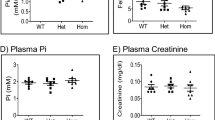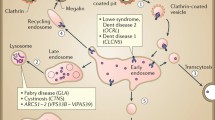Abstract.
Mutations in the gene CLCN5 encoding the vesicular chloride channel ClC-5 lead to Dent's disease, an X-linked renal disorder. Dent's disease is characterised by proteinuria, hyperphosphaturia and hypercalciuria, which eventually lead to kidney stones and nephrocalcinosis. As it was unclear how mutations in a chloride channel might cause these symptoms, we and others have generated genetic mouse models to elucidate the underlying pathophysiological mechanisms. We review results obtained from these three mouse models and present new data on endosomal acidification and vitamin D metabolism in ClC-5 knock-out (KO) mice. ClC-5 is expressed in apical endosomes of proximal tubular cells where it co-localizes with endocytosed proteins and the proton ATPase. ClC-5 may provide an electric shunt for the efficient operation of the electrogenic H+-ATPase. We confirmed this hypothesis by showing that endosomes from CLCN5 KO mice are acidified at a significantly lower rate than wild-type endosomes. This probably results in the drastic impairment of endocytosis observed in ClC-5 KO mice. Parathyroid hormone (PTH) is filtered into the lumen of the nephron, where it is endocytosed and degraded by proximal tubular cells. The defective endocytosis in ClC-5 KO mice entails an increased luminal concentration of PTH, subsequent stimulation of apical PTH receptors which causes an increased endocytosis of the phosphate transporter NaPi and phosphaturia. We now show that it also results in up-regulation of proximal tubular α-hydroxylase that generates the active form of vitamin D from its precursor. We discuss how the primary defect in endocytosis leads via secondary changes in calciotropic hormones to the tertiary symptoms hyperphosphaturia, hypercalciuria and kidney stones.
Similar content being viewed by others
Author information
Authors and Affiliations
Additional information
Electronic Publication
Rights and permissions
About this article
Cite this article
Günther, W., Piwon, N. & Jentsch, T.J. The ClC-5 chloride channel knock-out mouse – an animal model for Dent's disease. Pflugers Arch - Eur J Physiol 445, 456–462 (2003). https://doi.org/10.1007/s00424-002-0950-6
Received:
Accepted:
Issue Date:
DOI: https://doi.org/10.1007/s00424-002-0950-6




